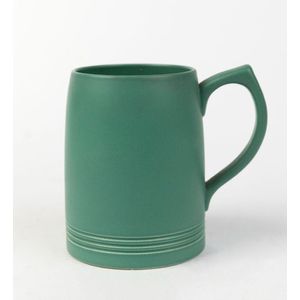
Wedgwood Green Glazed Pottery Tankard by Keith Murray, 1935
Wedgwood green glazed pottery tankard by Keith Murray, circa 1935, stamped 'Keith Murray, Wedgwood, made in England', 13 cm high

Keith Murray Wedgwood Moonstone Faceted Pottery Vase, circa 1932
Wedgwood 'Moonstone' faceted English pottery vase designed by Keith Murray, circa 1932, stamped 'Keith Murray, Wedgwood, made in England, Moonstone', with additional impressed marks, 19 cm high, 28.5 cm diameter

Wedgwood Keith Murray Jade Green Ribbed Vase, 15.5 cm
Keith Murray for Wedgwood, spherical ribbed vase, rich jade green glaze, stamped mark to base, pinprick glazing fault, 15.5 cm high

Keith Murray Moonstone Glaze Vase with Minor Hairline, Bates Label
Keith Murray 'Bomb' vase ribbed, moonstone glaze with 'Km' mark, minor hairline to top. Original Bates label. Height 16.5 cm

Moonstone Glazed Ribbed Vase by Keith Murray, 14.5 cm Height
Keith Murray small ribbed vase in moonstone glaze height 14.5 cm, KM mark to base

Keith Murray Wedgwood Straw Glazed Shoulder Vase, 19 cm Height
Medium size height 19 cm. Keith Murray Wedgwood straw glazed shoulder vase. Height 19 cm. KM circular mark.
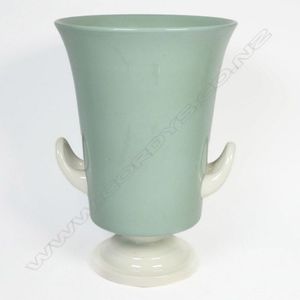
Wedgwood Green and White Urn Vase by Keith Murray
Keith Murray Wedgwood urn vase green and white. KM circular mark. Height 20.5 cm.

Keith Murray for Wedgwood Large Flared Vase, Shape No. 3842
Keith Murray for Wedgwood, large matt straw flared vase, lathe turned bands to the sides, shape no. 3842, printed circular manufacturer's mark with initials 'Km' in blue to the base, height 23.5 cm

Keith Murray for Wedgwood Chinese Lantern Vase, 15.5 cm
Keith Murray for Wedgwood, small matt straw 'Chinese Lantern' vase, shape no. 3765, printed and impressed manufacturer's marks with full facsimile signature in blue to the base, height 15.5 cm. Provenance: Purchased from Dunbar Sloane. Mike Pohl…

Keith Murray Wedgwood Moonstone Chinese Lantern Vase, Provenance Mike Pohl
Keith Murray for Wedgwood, small moonstone 'Chinese Lantern' vase, shape no. 3765, printed circular manufacturer's mark with initials 'Km' in blue to the base, height 16 cm. Provenance: Purchased from Shand Antiques, Christchurch. Mike Pohl collection.
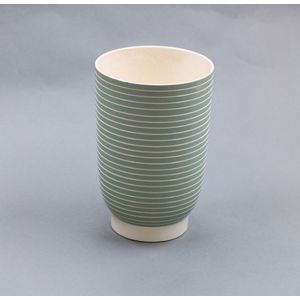
Rare Keith Murray for Wedgwood two-tone slip cylindrical vase
Keith Murray for Wedgwood, rare tall two-tone slip cylindrical vase, with celadon glaze and thin lathe turned bands in white, shape no. 4215 (faint glaze crack), printed manufacturer's mark with full facsimile signature in green to the base, height 18.5…

Keith Murray for Wedgwood Large Moonstone Flared Bowl, Provenance Included
Keith Murray for Wedgwood, large moonstone flared bowl, with step-cut sides, shape no. 3753, printed circular manufacturer's mark with initials 'Km' in blue to the base, diameter 19.5 cm. Provenance: Purchased from Gary Langsford, Auckland. Mike Pohl…
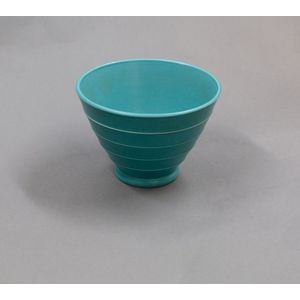
Wedgwood Duck-Egg Blue Flared Bowl, Keith Murray, Provenance Pohl
Keith Murray for Wedgwood, small duck-egg blue flared bowl, with step-cut sides, shape no. 3753, printed circular manufacturer's mark with initials 'Km' in blue to the base, diameter 15 cm. Provenance: Mike Pohl collection.
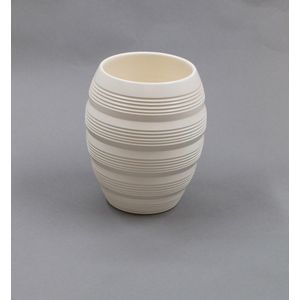
Keith Murray Wedgwood Moonstone Barrel Vase, Provenance Mike Pohl Collection
Keith Murray for Wedgwood, moonstone 'Barrel' vase, of ovoid form, with ribbed body, shape no. 3868 (bruise to foot), printed circular manufacturer's mark with initials 'Km' in blue to the base, height 16 cm. Provenance: Mike Pohl collection.

Rare Keith Murray Wedgwood duck-egg blue shoulder vase, shape no. 3805
Keith Murray for Wedgwood, rare large duck-egg blue shoulder vase, tapering conical shape with five lathe turned bands to the sides and three to the sloping shoulders, shape no. 3805, printed circular manufacturer's marks with initials 'Km' in blue to the…

Keith Murray Wedgwood Large Green Shoulder Vase, Provenance Mike Pohl
Keith Murray for Wedgwood, large vivid green shoulder vase, of tapering conical shape with five lathe turned bands to the sides and three to the sloping shoulders, shape no. 3805, printed and impressed manufacturer's marks with full facsimile signature in…

Keith Murray for Wedgwood Large Moonstone Shoulder Vase, Provenance Included
Keith Murray for Wedgwood, large moonstone shoulder vase, of tapering conical shape with five lathe turned bands to the sides and three to the sloping shoulders, shape no. 3805, printed manufacturer's mark with full facsimile signature in blue to the base…

Rare large bronze basalt vase by Keith Murray for Wedgwood
Keith Murray for Wedgwood, rare large bronze basalt vase, of cylindrical form with three lathe turned bands to the upper section, shape no. 3877, printed and impressed manufacturer's marks with full facsimile signature in red to the base, height 19.5 cm.…

Keith Murray Wedgwood green ribbed vase, footed, shape no. 4314
Keith Murray for Wedgwood, matt green ribbed vase, with flared sides, raised on a foot, shape no. 4314, printed and impressed manufacturer's marks with initials 'Km' in blue to the base, height 18.5 cm. Provenance: Purchased in the UK. Mike Pohl…

Keith Murray Wedgwood rare cigarette box with matt green glaze
Keith Murray for Wedgwood, rare cigarette box, with matt green glaze, shape no. 4112, printed and impressed manufacturer's marks with initials 'Km' in blue to the base, width 10 cm. Provenance: Purchased from Narcisse, Sydney. Mike Pohl collection.

Rare Keith Murray for Wedgwood Moonstone Shoulder Vase, Provenance Listed
Keith Murray for Wedgwood, rare small moonstone shoulder vase, of tapering conical shape with five lathe turned bands to the sides and three to the sloping shoulders, shape no. 3805, printed circular manufacturer's mark with initials 'Km' in blue to the…

Keith Murray for Wedgwood Green Ovoid Vase, Provenance Mike Pohl
Keith Murray for Wedgwood, small matt green ovoid vase, finely ribbed, shape no. 3870, printed and impressed manufacturer's marks with full facsimile signature in blue to the base, height 14 cm. Provenance: Purchased in the UK. Mike Pohl collection.

Keith Murray for Wedgwood Duck-Egg Blue Footed Bowl, Provenance
Keith Murray for Wedgwood, small duck-egg blue footed bowl, the flared body with a single lathe turned band below the rim, shape no. 3813, printed circular manufacturer's mark with initials 'Km' in blue to the base, diameter 17 cm. Provenance: Purchased…

Keith Murray for Wedgwood Rare Small Footed Bowl, 17cm Diameter
Keith Murray for Wedgwood, rare matt straw small footed bowl, the flared body with a single lathe turned band below the rim, shape no. 3813, printed circular manufacturer's mark with initials 'Km' in blue to the base, diameter 17 cm. Provenance: Purchased…
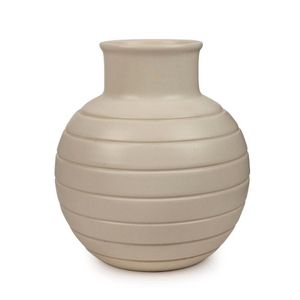
Keith Murray designed Wedgwood cream pottery vase, 16 cm high
Wedgwood cream pottery vase designed by Keith Murray, stamped 'Wedgwood of Etruria & Barlaston, K.M., Made in England', 16 cm high

Keith Murray Wedgwood Shoulder Vase: Straw Matt Glaze, Incised Bands
A Keith Murray for Wedgwood shoulder vase, a cylindrical tapering form, straw matt glaze, with incised bands around the exterior. Transfer mark to base. Small cup at the opening, height 19 cm, depth 14.5 cm

Black Basalt Vase by Keith Murray Wedgwood
Keith Murray Wedgwood uncommon black basalt vase, finely ribbed, ovoid form. Red signature and other printed and impressed marks, height 13.5 cm.

Green Wedgwood Flared Vase by Keith Murray
A large green Keith Murray Wedgwood flared vase, plain with lathe cut bands. Full signature and printed mark to base. Height 23.5 cm.
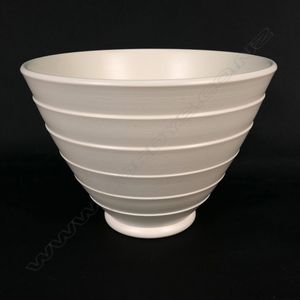
Wedgwood Keith Murray Moonstone Vase - 14cm Height
A Wedgwood Keith Murray vase, conical shape with six lathe turned bands Moonstone glaze. Printed circular mark. Height 14 cm, Diameter 19.5 cm

Keith Murray Wedgwood Ribbed Vase, Green Glaze, 16.5cm
Keith Murray for Wedgwood, Ribbed vase, matt green glazed ceramic, printed blue Keith Murray signature mark and further impressed factory marks to the base, Height 16.5 cm

Keith Murray Wedgwood Art Deco Vase
Wedgwood green glazed Art Deco porcelain vase by Keith Murray, stamped 'Keith Murray, Wedgwood, made in England', note: appears to be restored, 26 cm high

Small Moonstone Wedgwood Keith Murray Mug
A Wedgwood Keith Murray mug Small size, Moonstone glaze, height 9.5 cm

Keith Murray Art Deco Amber Glass Vase
An Art Deco amber glass vase attributed to Keith Murray for Stevens & Williams / Royal Brierley beaker form, polygonal with four pairs of fluted vertical channels. Scratch engraved mark 'S&W KM -/33', height 190, Diameter 16.5 cm

Keith Murray Wedgwood Green Vase
A Keith Murray for Wedgwood spherical vase, with a matte green glaze and lathed banding to body. Keith Murray signature and Wedgwood marks to base, height 19 cm, depth 17.5 cm, Keith Murray (1892-1981) started working with edgwood in the early 1930s.…

Keith Murray Wedgwood Vase
A vase designed by Keith Murray for Wedgwood ovoid with fifteen fine lathe turned bands, straw glaze. Circular printed mark, height 14 cm

Keith Murray Wedgwood Campana Urn Vase
A Wedgwood vase designed by Keith Murray tall campana urn shape, celadon glazed body with white handles and foot. Small chip to foot. Circular printed mark, height 20.5 cm

Keith Murray Wedgwood Tazza in Jade Green Glaze
A Wedgwood tazza designed by Keith Murray circular lathe turned platter raised on short tapering foot. Jade green glaze. Facsimile signature, printed and impressed marks diameter 23 cm, height 5 cm

Keith Murray Wedgwood Bowl
A Wedgwood broad rimmed bowl designed by Keith Murray matt white glaze, triple lathe turned band to the broad everted flat rim. Circular printed mark and impressed Wedgwood, diameter 24.5 cm

Keith Murray Wedgwood Conical Vase, Green Glaze, Restored Rim
A Wedgwood Keith Murray conical vase matt green glaze, some restoration to rim and discolouration of interior, diameter 19.5 cm

Keith Murray Wedgwood Vase
An experimental vase designed for Wedgwood by Keith Murray, compressed circular shape with small flared mouth and tapering circular foot ring. Uncommon cream gloss glaze with incised encircling lines to the body, the foot and mouth interior contrasting…

Wedgwood Keith Murray Straw Glaze Vase
A Wedgwood Keith Murray vase. Straw matt coloured glaze, cylindrical tapering form with seven lathe turned bands. Circular printed mark to base, height 18.5 cm

Keith Murray Wedgwood Moonstone Shoulder Vase
A Wedgwood shoulder vase, designed by Keith Murray, moonstone glazed, tapering conical shape with five lathe turned bands to the sides, the top with sloping shoulders. Printed circular factory mark and impressed 'S', height 29 cm.
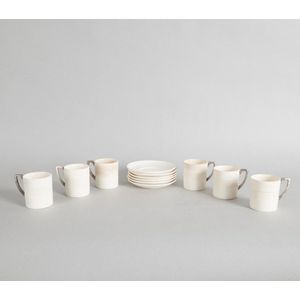
Keith Murray Wedgwood Demitasse Cups and Saucers
A suite of demitasse cups and saucers designed by Keith Murray for Wedgwood, with a lathed band of lines to the center of the cups and silver gilt handles. 'Wedgwood Km' mark to base. Some wear, height 6.5 cm, diameter 12 cm. Keith Murray (1892-1981)…

Keith Murray for Wedgwood Green Matte Glaze Mugs
A pair of Keith Murray for Wedgwood mugs, in a matte green glaze. Keith Murray signature and Wedgwood factory marks to base, height 12.5 cm, width 13 cm. Keith Murray (1892-1981) started working with Wedgwood in the early 1930s. Originally in creamware,…

Keith Murray Wedgwood Spherical Vase
A Keith Murray for Wedgwood spherical vase, matte straw glaze, and incised banding to body. Impressed maker's mark to base, height 16 cm, diameter 14 cm. Keith Murray (1892-1981) started working with Wedgwood in the early 1930s. Originally in creamware,…

Keith Murray Wedgwood Shoulder Vase in Green Glaze
A shoulder vase by Keith Murray for Wedgwood, shape 3805, in a matt green glaze. Keith Murray signature and Wedgwood factory marks to base, height 28.5 cm, diameter 20 cm. Keith Murray (1892-1981) started working with Wedgwood in the early 1930s.…

Keith Murray Wedgwood Spherical Vase
A Keith Murray for Wedgwood spherical vase, with a matte white glaze and lathed banding to body. Keith Murray signature and Wedgwood marks to base, height 15.5 cm, diameter 14 cm. Keith Murray (1892-1981) started working with Wedgwood in the early 1930s.…

Keith Murray Wedgwood Bowl with Modernist Design
A Keith Murray for Wedgwood bowl, with a white matte glaze, and lathed concentric circles to top and bottom rim. 'Wedgwood of Etruria' mark to base. Chip to foot, height 10 cm, diameter 22 cm. Keith Murray (1892-1981) started working with Wedgwood in the…
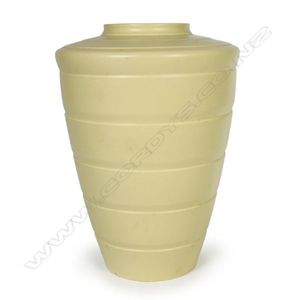
Keith Murray Wedgwood Shoulder Vase with Straw Mat Glaze
A Keith Murray for Wedgwood shoulder vase, cylindrical tapering form, straw mat glaze, incised lathe turned bands, circular printed mark to base, two tiny chips and a small crack to base. Height 21 cm.

Keith Murray Wedgwood Vase with Lathe Turned Bands
A Keith Murray for Wedgwood vase, cylindrical tapering form, straw matt glaze, incised lathe turned bands, circular printed mark to base. Height 18.5 cm.

Keith Murray Wedgwood Ashtray, 1930
A Keith Murray for Wedgwood ashtray, C.1930. Matte white glaze. Stamped maker's mark to base, height 2.5 cm, diameter 10 cm

Keith Murray Wedgwood Ashtray
A Keith Murray for Wedgwood ashtray, C.1930. Matte straw glaze. Impressed and stamped maker's mark to base, height 2.5 cm, diameter 10 cm

Moonstone Keith Murray Wedgwood Ashtray
A Keith Murray for Wedgwood ashtray, C.1930. Moonstone glaze. Stamped maker's mark to base, height 2.5 cm, diameter 10 cm

Keith Murray Wedgwood Ashtray, 1930
A Keith Murray for Wedgwood ashtray, C.1930. Matte green glaze. Impressed and stamped maker's mark to base, height 2.5 cm, diameter 10 cm

Keith Murray Wedgwood Flared Vase, c.1945, 16cm
A Keith Murray for Wedgwood flared vase, c.1945. Stamped to base. Repair to foot, height 16 cm, diameter 23 cm

Keith Murray Wedgwood Ashtray, C.1930
A Keith Murray for Wedgwood ashtray, C.1930. Matte blue glaze. Impressed and stamped maker's mark to base, height 2.5 cm, diameter 10 cm

Keith Murray Wedgwood Blue Vase, 24 cm
A Keith Murray for Wedgwood spherical vase, in matte blue with lathe banding to body. Stamped manufacturers mark to base, height 24 cm, diameter 24 cm

Keith Murray Basalt Elliptical Form Bowl
A stunning Keith Murray basalt elliptical form bowl, raised on circular foot. Single band to the upper rim. Stamped and impressed maker's mark to base, height 10 cm, diameter 16.5 cm

Moonstone Wedgwood Vase by Keith Murray
A Keith Murray moonstone shoulder vase, designed for Wedgwood c. 1930. Glazed in the pearlescent 'Moonstone' colourway. Stamped and impressed maker's mark to base, height 29 cm, diameter 22 cm

Keith Murray Basalt Ribbed Vase - 16 cm
A Keith Murray basalt ribbed vase, ovoid form with banding to body. Stamped and impressed maker's mark to base, height 16 cm, diameter 13 cm

Keith Murray Wedgwood Spherical Vase in Rare Blue Glaze
A Keith Murray for Wedgwood spherical vase, rare duck shell blue glaze. Incised banding to body. Impressed maker's mark to base, height 16 cm, diameter 14 cm

Wedgwood Football Vase by Keith Murray
A Keith Murray for Wedgwood football vase, C.1930. Lathe banding to body. Matte green glaze. Impressed and stamped maker's mark to base, height 20 cm, diameter 20 cm

Keith Murray Wedgwood Spherical Vase - 16cm Height
A Keith Murray for Wedgwood spherical vase, matte straw glaze. Incised banding to body. Impressed maker's mark to base, height 16 cm, diameter 14 cm

Keith Murray Wedgwood Porcelain Tankards (or) Set of Three Keith Murray Tankards
Keith Murray: three Wedgwood cream and yellow porcelain tankards. The two yellow examples with signature stamps, Keith Murray Wedgwood, made in England, the other stamped, Wedgwood of Etruria & Barlaston, made in England, K.M. The tallest 12 cm high

Keith Murray Green Spherical Vase
A Keith Murray green spherical vase, hand thrown with lathe turned concave bands. Height 18.5 cm. Impressed full signature mark. Height 18.6 cm. Note: Keith Murray was born in 1892 in Mt. Eden Auckland. Emigrating to England at age 14. As an officer with…

Keith Murray Green Bamboo Wedgwood Vase
Wedgwood vase, Keith Murray green bamboo ribbed shape. Signed Murray to base., height 25.5 cm

Signed Wedgwood Black Basalt Ribbed Vase
Keith Murray, Wedgwood black basalt ribbed vase, signed to base

Keith Murray Wedgwood Flared Bowl
Keith Murray for Wedgwood large, flared bowl, step-cut sides, gloss white glaze. Printed KM circular mark. Height 16.3 cm. Some tiny flake chipping.

Keith Murray Wedgwood Blue Glaze Vase
Keith Murray for Wedgwood large blue glaze vase, multiple concave bands to the spherical body, printed KM circular mark. Height 23.3 cm.

Keith Murray Wedgwood Brown Basalt Porcelain Vase with Ribbing
Keith Murray Wedgwood brown basalt porcelain vase with ribbed decoration, stamped 'Keith Murray, Wedgwood, made in England', 19 cm high, 13 cm wide

Keith Murray Wedgwood Spherical Vase, 22 cm
Keith Murray for Wedgwood, Spherical vase, matt straw glazed ceramic with lathe turned bands, printed blue Keith Murray signature mark and further impressed factory marks to the base, height 22 cm

Keith Murray Wedgwood Shoulder Vase
Keith Murray for Wedgwood, Shoulder vase, matt straw glazed ceramic (shape 3805), printed blue KM Wedgwood mark to the base, height 28.5 cm

Keith Murray Wedgwood Shoulder Vase
Keith Murray for Wedgwood, Shoulder vase, matt green glazed ceramic, printed blue Keith Murray signature Wedgwood mark and further impressed factory marks to the base, 28.5 cm high

Keith Murray Wedgwood Vase: Rare Pale Green Ovoid Shape
A vase by Keith Murray for Wedgwood, rare shape 4321, pale matt green glazed, tall ovoid with seven lathe turned bands. KM printed mark. Height 23 cm.

Signed Keith Murray Green Tankard
Wedgwood Keith Murray signed green tankard marked to base, height 12.5 cm

Wedgwood Keith Murray Moonstone 22-Piece Dinner Set
Keith Murray 'Moonstone' part dinner service. Manufactured by Wedgwood. Comprising, six dinner plates, six entree plates, five side plates, two lidded tureens, a gravy boat and a graduated pair of oval platters. Total 22 pieces.

Keith Murray Moonstone Glaze Fruit Bowl
Keith Murray for Wedgwood, fruit bowl, in moonstone glaze, stamped KM mark to the base, diameter 25.5 cm. Provenance: Damian Balle collection

Keith Murray Wedgwood Footed Bowl, 17cm
Keith Murray for Wedgwood, footed bowl, of flared form in glossy white glaze, stamped KM mark to the base, diameter 17 cm. Provenance: Damian Balle collection

Sage Green Vase by Keith Murray for Wedgwood
Keith Murray for Wedgwood, tapering cylindrical vase, with sage green glaze and five lathe turned bands, stamped KM mark to the base, height 20 cm. Provenance: Damian Balle collection

Keith Murray Wedgwood Moonstone Glaze Vase
Keith Murray for Wedgwood, tapering cylindrical vase, shape 3842 in moonstone glaze, stamped KM mark to the base, height 24 cm. Provenance: Damian Balle collection

Keith Murray Wedgwood Tall Vase with Lathe Turned Bands
A Keith Murray Wedgwood tall vase, matt white glaze, four incised lathe turned bands, printed mark to base, three small flake chips to base, height 23.5 cm.

Keith Murray Wedgwood Vase, 28cm
A Keith Murray Design Wedgwood tall shoulder vase, matt white glaze, traditional incised lathe turned bands. Early mark with full signature in green, height 28 cm.

Art Deco Wedgwood Fruit Bowl in Two-Tone Celadon Green
Keith Murray Wedgwood English Art Deco porcelain fruit bowl in celadon green and ivory two tone, circa 1940, stamped 'Keith Murray, Wedgwood, Made in England', 11.5 cm high, 28 cm diameter

Rare Keith Murray Shoulder Vase in Blue and Grey Glaze
An exceedingly rare Keith Murray shoulder vase, in a blue and grey glaze with vertical ribbing at intervals to the body. The top tapering into a flared mouth encircled by circumference lines. Impressed makers mark to base, height 30 cm, diameter 21 cm

Keith Murray Green Ceramic Vase - 15cm Height
Wedgwood Keith Murray matt green ceramic vase height 15 cm approx.

Keith Murray Wedgwood Ashtrays in Blue and Green Glazes
Keith Murray for Wedgwood, two ashtrays, in matt blue and green glazes, factory marks to the bases, The largest, 2.5 x 11.5 x 11.5 cm

Keith Murray Wedgwood Vase, C.1940
A Keith Murray for Wedgwood large vase, C.1940. An early design, with lathe banding and matte white glaze, height 23 cm, diameter 21 cm

Wedgwood Keith Murray Blue Bomb Vase
Keith Murray for Wedgwood Bomb vase, c. 1940 executed by Wedgwood, of ovoid shape, matte baby blue glaze, factory stamp 'K M Wedgwood, made in England?

Millicent Taplin's Platinum Lustre Half Pint Mugs, 1950
Keith Murray design platinum lustre half pint mugs, C1950, designed by Millicent Taplin

Green Wedgwood Keith Murray Ceramic Mug - 12 cm Height
Wedgwood Keith Murray green ceramic mug, marked to base, height 12 cm

Keith Murray Wedgwood Flared Bowl, 14cm
Keith Murray for Wedgwood flared large bowl, lathe turned banded design, matt white glaze, 'KM' printed mark to base, height 14 cm.

Keith Murray Wedgwood Vase, 15.5 cm
Keith Murray for Wedgwood spherical form vase, incised lathe turned banded decoration, cylinder neck. 'KM' printed mark to base, height 15.5 cm.

Murray's Serpentine Vase
Keith Murray for Wedgwood large vase, matt white glaze with serpentine lathe banding, an early design with printed full signature mark, height 22 cm.

Keith Murray Wedgwood Cylinder Vase, 15.5 cm
Keith Murray for Wedgwood cylinder form vase, lathe turned banded design, matt white glaze, printed 'KM' mark, height 15.5 cm.


 Loading more...
Loading more...